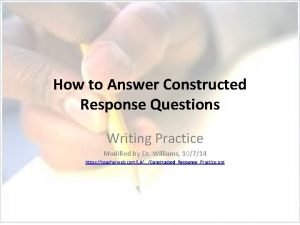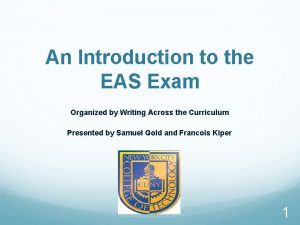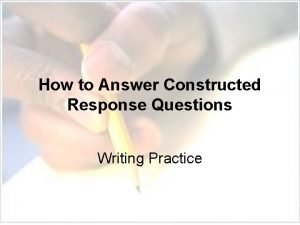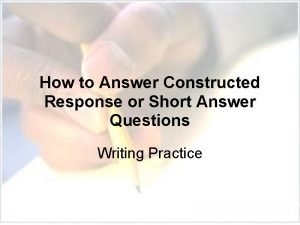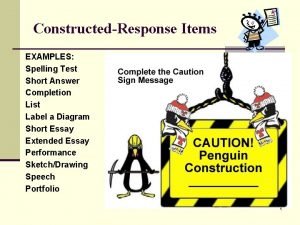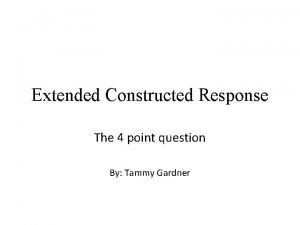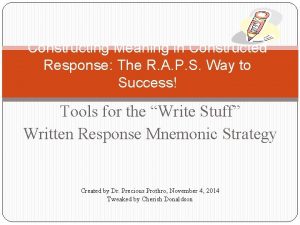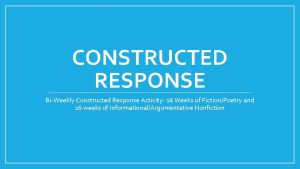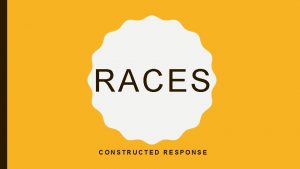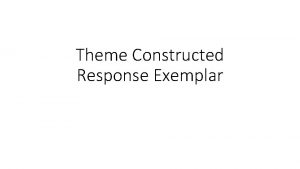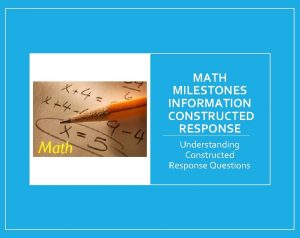Selected Response Template Selected Response Examples Constructed Response






- Slides: 6

Selected Response Template Selected Response Examples Constructed Response 2 -3 Point Reading Rubrics (Templates and Examples) Note: Options: A. “Canaries sing beautiful songs. ” B. “Parakeets will sit on your shoulder. ” C. “Parrots can talk to you. ” D. “Birds fly outdoors. ” Distractor Analysis: A. Incorrect: This sentence gives a reason why someone might want a bird as a pet. B. Incorrect: This sentence gives a reason why someone might want a bird as a pet. C. Incorrect: This sentence gives a reason why someone might want a bird as a pet. D. Correct: This sentence states a fact about birds. It does not give a reason why someone would want a bird as a pet. Stimulus Text: Birds Make Good Pets There are many reasons why people keep birds as pets. Canaries sing beautiful songs. Parakeets will sit on your shoulder. Parrots can talk to you. Birds fly outdoors. Pet birds can be fun. Item Stem: A student is revising this paragraph and needs to take out information that does not support why birds make good pets. Which of the following sentences does not support why birds make good pets?

Selected Response Standard Conversion to Question: Question Place the standard in the box below: Change the standard to a question with the addition of only a few words. Write three distractors and one correct answer. a) b) c). d) 12/16/2021 2

Question (prompt): 2 Point Reading Constructed Response Rubric Directions for Scoring Notes: Write an overview of what students could include in a proficient response with examples from the text. Be very specific and “lengthy. ” Scoring notes: “Teacher Language” Sufficient Evidence Specific Details Fully Supports with A proficient response: Gives sufficient evidence of the ability to [fill in with key language from the intended target] • Includes specific [inferences, opinions, identification, etc. ] that make clear reference to the text • Adequately supports the [inferences, opinions, identification, etc. ] with clearly relevant [details, examples, information] from the text • A partial response: • Gives limited evidence of the ability to [fill in with key language from the intended target] • Includes some [inferences, opinions, identification, etc. ] that make reference to the text • Supports the [inferences, opinions, identification, etc. ] with limited [details, examples, information] from the text A response gets no credit if it provides no evidence of the ability to [fill in with key language from the intended target], includes no relevant information from the text, or is vague. •

Question (prompt): 3 Point Reading Constructed Response Rubric Directions for Scoring Notes: Write an overview of what students could include in a proficient response with examples from the text. Be very specific and “lengthy. ” Scoring notes: “Teacher Language” Sufficient Evidence Specific Details Fully Supports with Sample Response “ Student Language” A proficient response: • Gives sufficient evidence of the ability to [fill in with key language from the intended target] • Includes specific [inferences, opinions, identification, etc. ] that make clear reference to the text • Fully supports the [inferences, opinions, identification, etc. ] with clearly relevant [details, examples, information] from the text A partial response: • Gives some evidence of the ability to [fill in with key language from the intended target] • Includes some specific [inferences, opinions, identification, etc. ] that make reference to the text • Adequately supports the [inferences, opinions, identification, etc. ] with relevant [details, examples, information] from the text A minimal response: • Gives limited evidence of the ability to [fill in with key language from the intended target] • Includes [inferences, opinions, identifications, etc. ] but they are not explicit or make only vague references to the text • Supports the [inference, opinion, identification, etc. ] with at least one [detail, example] but the relevance of that [detail, example] to the text must be inferred A response gets no credit if it provides no evidence of the ability to [fill in with key language from the intended target], includes no relevant information from the text, or is vague.

EXAMPLE OF A 2 POINT COMPLETED SHORT READING CONSTRUCTED RESPONSE RUBRIC A Note about constructed responses: Constructed response answers are not written “in stone. ” There is no perfect way a student should respond. Look for the general intent of the prompt and student response and follow the rubric below as much as possible. Use your best judgment. Unlike DOK-1 questions where there is one right and wrong answer, constructed responses are more difficult to assess. Overall consistency of intent based on most of your student responses can guide you. Quarter 1 CFA Constructed Response Answer Key Standard RI. 4. 2: 2 Point Short Reading Constructed Response Rubric Questions #15 (Prompt): What is the main idea of the text, Ellis Island: The Hunt for Alois Hanousek? Use key details from the text to support your answer. Teacher Language and Scoring Notes: Sufficient Evidence: The main idea of the text is how the two sisters found information about their great-grandfather Alois Hanousek. Specific indications could include details that support the main idea in a sequential style. Details could include (1) the sisters went to Ellis Island, (2) their great-grandfather probably went through Ellis Island, (3) Ellis Island kept records of immigrants and (4) they found records about Alois Hanousek. Full Support are the examples given around or about each detail. The first detail ( the sisters went to Ellis Island) is supported by the example that the sisters took a ferry from Battery Park on the southern tip of Manhattan and passed the Statue of Liberty to get to Ellis Island. The second details (their grandfather probably went through Ellis Island) is supported by the example that most immigrants arrived there from 1892 to 1954. The third detail (Ellis Island kept immigrant records) is supported by the example that the sisters arrived at the research center and began looking on a computer. The fourth detail (finding records of Alois) is supported by the example that “ My great-grandfather’s name. It was written as “Canousek. It had been spelled wrong at Ellis Island, ” and the information they learned about their great-grandfather. The student gives a proficient response by providing evidence of the main idea and uses specific examples from the text as well as details about (supports) each example. 2 1 0 In the text about Alois Hanousek, the main idea is that two sisters wanted to learn more about their greatgrandfather and how they did learn more. The sisters went to Ellis Island on a Ferry. They passed the Statue of Liberty. When they arrived they were amazed at how big it was. They also read that most immigrants had passed through there from 1892 to 1954. The girls went to the research center where immigrant records were kept. They found out that their great-grandfather did go through Ellis Island but his name was spelled Canousek instead of Hanousek. Their journey was successful. The student gives a partial response by providing some evidence of the main idea and some specific examples that reference the text as well as details about each example. Two sisters wanted to learn about their great-grandfather because no one really knew much about him. They planned a trip to Ellis Island to learn more and they did! They learned about his age and health. The student provides no evidence about the main idea and no relevant information or examples from the text. I think the Statue of Liberty was really neat for the immigrants to see! Standard RI. 4. 2 Determine the main idea of a text and explain how it is supported by key details; summarize the text. 5

EXAMPLE OF A 3 POINT COMPLETED SHORT READING CONSTRUCTED RESPONSE RUBRIC A Note about constructed responses: Constructed response answers are not written “in stone. ” There is no perfect way a student should respond. Look for the general intent of the prompt and student response and follow the rubric below as much as possible. Use your best judgment. Unlike DOK-1 questions where there is one right and wrong answer, constructed responses are more difficult to assess. Overall consistency of intent based on most of your student responses can guide you. Quarter 1 CFA Constructed Response Answer Key Standard RL. 4. 3: 3 Point Reading Constructed Response Rubric Question #8 (prompt): Describe Emily’s actions at Ellis Island that led to her enjoying the museum. Use specific details from the text to support your answer. Teacher Language and Scoring Notes: Emily went from little enthusiasm for being at the museum to enjoying her visit there, so much so she got lost from her family (sufficient evidence). With a grumpy attitude, her father let her go on her own. With this, “Emily felt her chest loosen slightly…Now that she was by herself, Ellis Island didn’t feel so bad. ” (details to support the prompt). “The sign said “Family Records, ” and it made something stir inside Emily’s brain, ” remembering her grandfather’s stories of immigrating to the U. S. as a child. “She began navigating” and found exciting information about her grandfather. From there she became fascinated with searching for other people. “She was so engrossed that she forgot the time. ” In the end, she realized it was nice to get to Ellis Island. 3 2 1 0 The student gives a proficient response by providing evidence of how Emily’s actions led to her enjoying the museum and uses specific details from the text to support each example. In the story, Lost on Ellis Island, Emily actions showed that she liked going to Ellis Island. I know this because she was grumpy at first but in the end she said that it was nice. She also felt better being away from her family and exploring on her own. She was excited about what she found about her grandpa and others. The student gives a proficient response by providing some evidence of how Emily’s actions led to her enjoying the museum and some specific details from the text to support each example. In the story, Emily enjoyed Ellis Island. She went off on her own in the museum. She went to the Family Records Room and found out information about her grandfather. The student gives a minimal response by providing limited evidence of how Emily’s actions led to her enjoying the museum with few specific details from the text. Emily had fun at Ellis Island. She learned a lot about her grandpa. The student provides no evidence of how Emily’s actions led to her enjoying the museum. Emily is a girl in the story about Ellis Island. Standard RL. 4. 3 Describe in depth a character, setting, or event in a story or drama, drawing on specific details in the text (e. g. , a character's thoughts, words, or actions).
